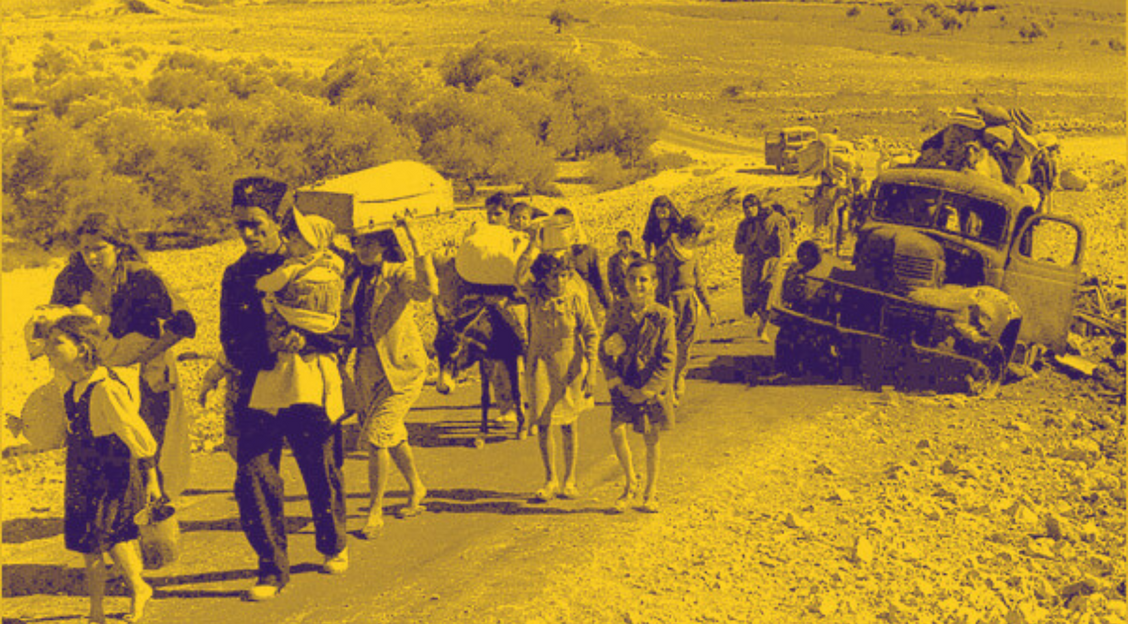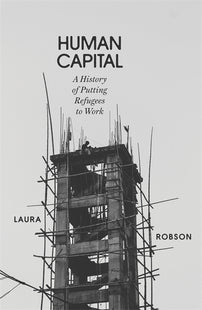The creation of a new refugee
Laura Robson charts the creation of “Palestine refugees,” which became a valuable way of differentiating between displaced Europeans and Palestinians post-1948.

As the Second World War ground to a grim halt, the world did indeed seem to need remaking. The epic displacements of the war remained unresolved; huge swathes of Europe were in ruins; and another mass dispossession was already unfolding in the Middle East. This time it was the rising American empire that would take the lead in constructing internationalist “solutions” for the era’s multiple refugee crises—like its predecessors, with a perpetual eye to supporting its own imperial expansion.
At the end of the war Europe was home to millions of refugees, many of them detained in what were designed to be temporary camps under the auspices of the wartime United Nations Relief and Rehabilitation Administration. With the cessation of hostilities, the question of what to do with the refugees became ever more urgent—and proved as difficult as ever, since the Allied countries were no more eager to take in homeless European Jews now than they had been before the war and the Holocaust. UNRRA therefore dealt with most of the displaced people under its remit through the controversial practice of repatriation, sometimes undertaken against the will of the refugees themselves. Still, there remained a so-called “hard core”—a not inconsiderable population of some one and a half million people—who were still stranded in camps when UNRRA closed its doors. Its successor, the new International Refugee Organization (IRO), took its inspiration not from UNRRA’s repatriation approach but from earlier interwar refugee policies. Over the next few years, the IRO’s primary strategy for disgorging the remaining refugees from the European camp system would be the construction of a racially conscious global employment scheme that connected refugees—privileging the able-bodied white Christian variety—with assorted kinds of menial labor, inside and especially outside Europe.
The racial consciousness in evidence at the IRO was becoming ever more central to an increasingly formalized internationalist refugee regime, a development supremely evident in the response to the next major global crises of displacement. First, the new United Nations managed to avoid any consideration of the brutal forced migration marking the aftermath of Indian partition by declaring it a mere domestic political problem producing internal migration but not refugees. Then, in 1948, Zionist forces seeking to establish a demographically Jewish state expelled some three-quarters of a million Palestinian Arabs from what was now Israel, following Britain’s announcement that it would relinquish its mandate over Palestine to the newly formed United Nations.
Facing a new non-European refugee crisis—which the UN, given its central role in the making of this particular calamity, could not simply evade— another legal solution presented itself. The next few years witnessed the construction of an international legal system that differentiated between normative “refugees,” defined as those displaced in Europe during the war years who required some form of legal recourse, and “Palestine refugees,” in perpetual limbo pending some political settlement and therefore eligible for material aid but not legal assistance, asylum, or political advocacy.
It was an innovative distinction that would serve as foundational for the global refugee regime under construction in two different ways. In the first instance, this establishment of the legal category of the “Palestine refugee” had the practical effect of keeping Palestinians confined to Arab host states, and opened up new possibilities for the regional use of refugee labor—this time, mainly in the interests of American economic advancement. The mostly American-funded United Nations Relief and Works Agency (UNRWA), established in 1949 to provide on-the-ground assistance to the “Palestine refugees,” pressed hard in its early years for mass Palestinian employment in American-backed industrial work across the Middle East, using displaced people as laborers on foreign-backed projects of “Third World” development in Egypt, Jordan, and the Gulf. It was a new iteration of the old League and IRO schemes for refugee employment, now keyed to the political and economic goals of a Cold War–era “Third World” developmentalism.
Even more crucially, though, the delineation of Palestinians as a distinct legal category in this emerging international system suggested an intriguing possibility: that the international community might be able to effectively control refugee resettlement, while plausibly claiming to defend refugee rights, simply by legally distinguishing among different types of refugees. This scheme of legal segregation served as a crucial premise for the much-lauded 1951 Convention Relating to the Status of Refugees, which formally defined the parameters of refugeedom and established a set of rights for those who qualified—carefully constructing the rights of a presumably normative European “refugee” over the lesser protections offered to the “Palestine refugee.”
The convention was billed as a humanitarian triumph for its guarantees to the displaced—“one of the outstanding achievements of the 20th century,” as High Commissioner for Refugees Sadako Ogata would put it decades later. But its distinction between types of refugee offered something less salubrious: a valuable procedural model for differentiating between displaced Europeans entitled to resettlement and non-Europeans subject to more or less permanent containment, without openly acknowledging the increasing centrality of race to the practice of international refugee assistance.
— An edited excerpt from Human Capital: A History of Putting Refugees to Work by Laura Robson.
[book-strip index="1" style="buy"]
